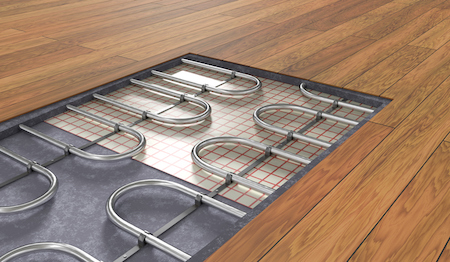The Pros and Cons of Heated Flooring
Information is brought to you by

The Pros and Cons of Heated Flooring
While you might be considering adding heated flooring to your new home, there are a lot of questions to ask before you put your money into this luxury feature. If you’re looking for another level of comfort in your home, it’s a great option—but it does come with a hefty price tag. Here’s what you need to know:
Pros
- Durable and reliable. This method of heating lasts longer than a regular home furnace—with proper care it can last up to 35 years.
- Comfortable. There’s no better feeling than a warm floor on a cold day, especially when you first get out of the shower. No one enjoys stepping on cold tile, so bathrooms are particularly popular options for heated flooring.
- Saves you money in the long term. Since radiant floor heating warms from the floor up, you’ll be able to set your thermostat at a lower temperature to feel just as warm.
- Quiet. Because it does not require a blower, there is no extra noise produced when running it.
- Distributes heat evenly and consistently throughout each room.
- Better for allergy sufferers, since traditional central air heating pushes dust, dirt and pollen through the vents and around your home.
- Customizable. Electric floor heating allows for the option of only having heated flooring in certain rooms—so you can customize where you want it.
- Hidden, so your home has more space and less unattractive radiators.
- Versatile. Can be installed under any flooring.
- Profitable. Increases the value of your home.
Cons
- Costly. Installation will cost more than replacing a furnace, and hydronic systems are more expensive than electric.
- Not ideal for older homes as you will have to tear out existing flooring in order to install them. Wait until it’s time for a remodel before considering it.
- Repairs are costly. Because the system is under the floor, this also means repairs to the system are more costly as well. Since heating elements are out of sight, it can be hard to find the problem area.
- Slower to warm up the house than traditional heating. Especially true for water heating, which can take a few hours to circulate enough hot water to warm the home (but since they retain heat well, this allows for use in off peak hours, saving your utility bills).

Comments
Post a Comment